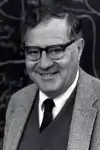Jerome L. Singer
Jerome L. Singer (February 6, 1924 – December 14, 2019) was an American clinical psychologist. He was a Professor Emeritus of Psychology at the Yale School of Medicine. He was a fellow of the American Psychological Association, the American Association for the Advancement of Science and the New York Academy of Sciences.[1]
Jerome L. Singer | |
|---|---|
 | |
| Born | February 6, 1924 New York City, New York, U.S. |
| Died | December 14, 2019 (aged 95) New Haven, Connecticut, U.S. |
| Education | City College of New York University of Pennsylvania |
| Occupation | Clinical psychologist |
| Employer | Yale School of Medicine |
| Spouse(s) |
Dorothy G. Singer
(m. 1949; died 2016) |
Early life
Singer was born in New York City on February 6, 1924.[2] He was educated at the City College of New York and at the University of Pennsylvania where he obtained his PhD in 1951.[2] He was enlisted in the United States Army where he served as a staff sergeant from 1943 through 1946.[3][2] In the Army, he worked in counter intelligence, serving in the Philippines, New Guinea, and Japan.[4]
Career
In 1963, he was recruited as a full professor and director of the clinical psychology training program for the City University of New York.[5] Singer became considered "the father of daydreaming" and he "has laid the foundations for virtually all current investigations of the costs and benefits of daydreaming and mind-wandering".[6]
To study daydreaming, Singer and co-worker John S. Antrobus of the City University of New York developed a questionnaire designed to measure the various dimensions that characterize the individual's inner life.[7] They called this instrument the Imaginal Process Inventory (IPI).[7][8][9]
Singer and co-workers described the IPI:
The 28 subscales of this self-report measure of ongoing thought predisposition attempt to sample various domains of mentation style (such as propensity for boredom or distractibility, rate of mentation, degree of visual or auditory imagery during daydreaming), orientation toward daydreaming more generally (for example, the degree to which an individual can become totally absorbed in fantasy activity, the degree to which daydreaming is accepted as relatively "normal and even desirable"), and specific fantasy patterns (such as sexual content, hostile-aggressive content, or fantasies of guilt).[10]
Singer and his co-workers studied several aspects of daydreaming, including childhood development and daydreams,[11][12] the psychotherapeutic use of daydreams,[13] and drug use and daydreaming.[10]
He worked in close partnership with his wife, Dorothy. They co-directed the Yale University Family Television Research and Consultation Center, which provided consultation to many influential children's television programs, including Mister Rogers' Neighborhood and Barney & Friends.[4][14] He was a fellow of the American Psychological Association and the American Association for the Advancement of Science.[4][2]
Personal life and death
From 1949 until her death in 2019, he was married to Dorothy G. Singer.[15] They had three sons.[3]
Singer died at Yale New Haven Hospital in New Haven, Connecticut, on December 14, 2019, at 95 years old.[3]
References
- "Jerome Singer, PhD". Sage Publishing. Retrieved May 23, 2016.
- Biographical Dictionary of Psychology. Routledge. 2016. ISBN 9781136798856. Retrieved December 20, 2019.
- "Obituary". The New Haven register. Retrieved December 17, 2019.
- "Reflections on Pretend Play, Imagination, and Child Development: An Interview with Dorothy and Jerome L. Singer" (PDF). American Journal of Play. 6 (1): 1. Fall 2013.
- Person Schemas and Maladaptive Interpersonal Patterns. University of Chicago Press. 1991. p. 429. ISBN 9780226353753. Retrieved December 20, 2019.
jerome l singer director of the clinical psychology training program.
- Kaufman, Scott Barry (December 10, 2013). "Conversation on Daydreaming with Jerome L. Singer". Scientific American.
- Singer, J. L.; Antrobus, J. S. (1963). "A factor analytic study of daydreaming and conceptually-related cognitive and personality variables". Perceptual and Motor Skills. 17: 187–209. doi:10.2466/pms.1963.17.1.187. PMID 14045737. S2CID 46102330.
- Singer, J. L.; Antrobus, J. S. (1970). Manual for the Imaginal Processes Inventory. Educational Testing Service.
- Singer, J. L.; Antrobus, J. S. (1972). Sheehan, P. (ed.). Daydreaming, imaginal processes, and personality: A normative study. The Function and Nature of Imagery. Academic Press.
- Segal, B.; Huba, G. J.; Singer, J. L. (1980). "ch.2". Drugs, Daydreaming, and Personality. New York: Routledge.
- Singer, J. L, ed. (1973). The child's world of make-believe: experimental studies of imaginative play. New York: Academic Press. ISBN 9780126466607.
- Singer, J. L. (1977). "Imagination and Fantasy Play in Early Childhood: Some Educational Implications". Journal of Mental Imagery. 1: 127–144.
- Singer, J. L. (1974). Imagery and daydream methods in psychotherapy and behavior modification. New York: Academic Press.
- Rierden, Andi (April 30, 1989). "Television Is Like Having a Stranger In". The New York Times. Retrieved December 20, 2019.
- Signorielli, Nancy (1996). Women in Communication: A Biographical Sourcebook. Bloomsbury Academic. ISBN 9780313291647. Retrieved December 20, 2019.